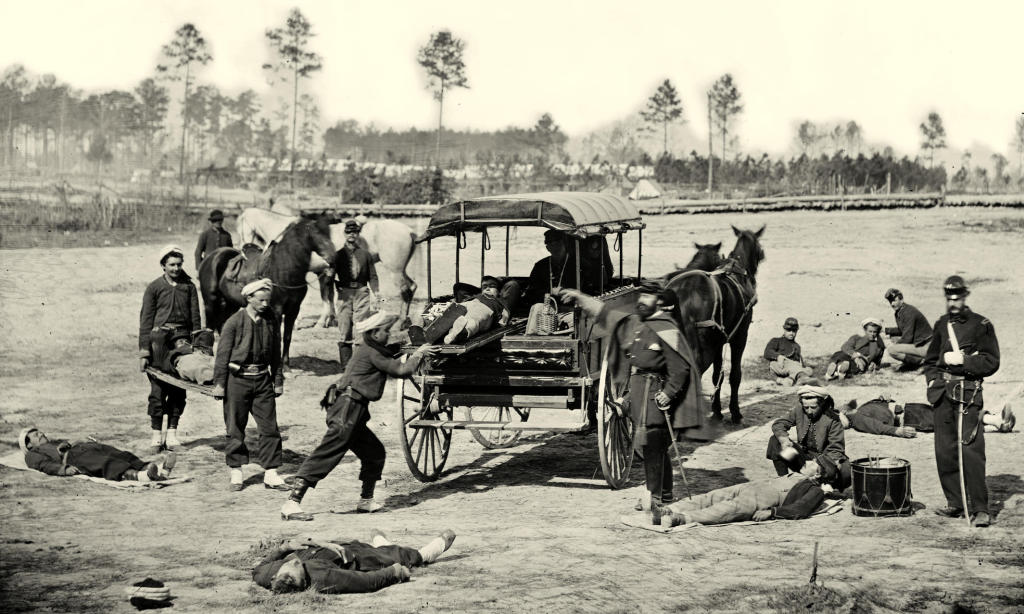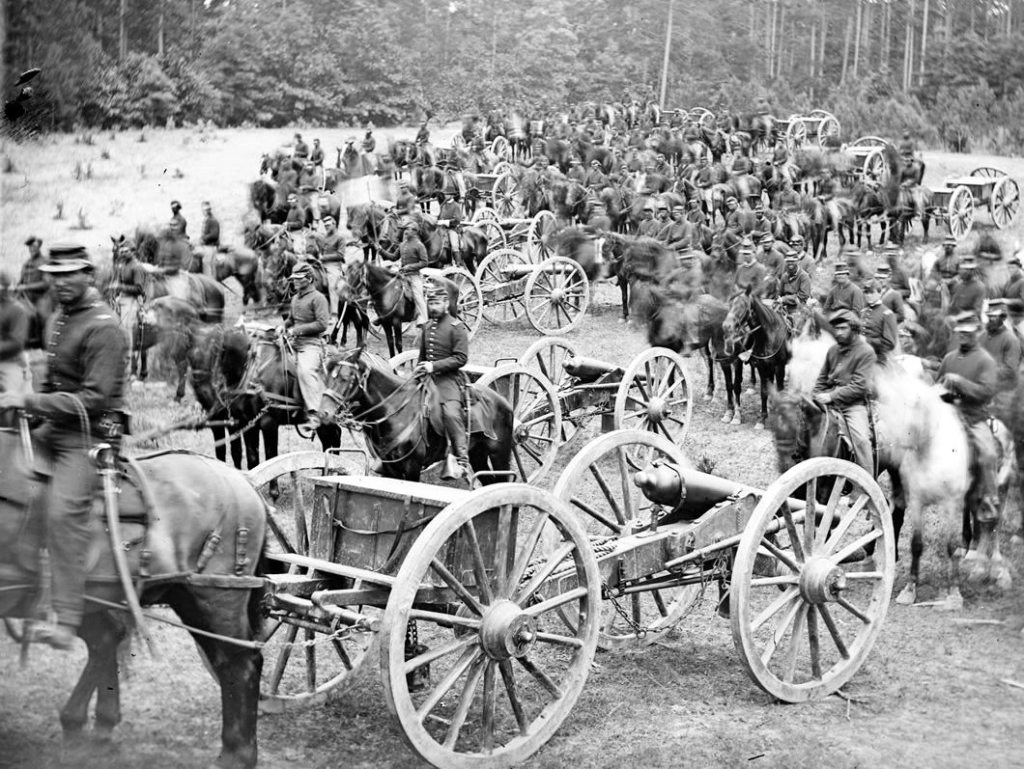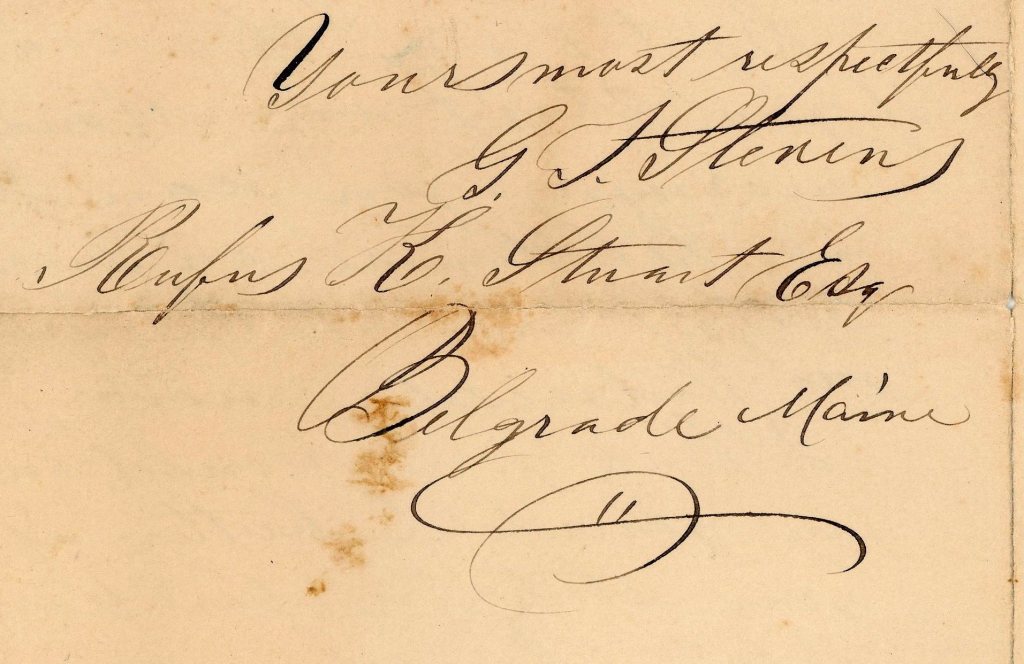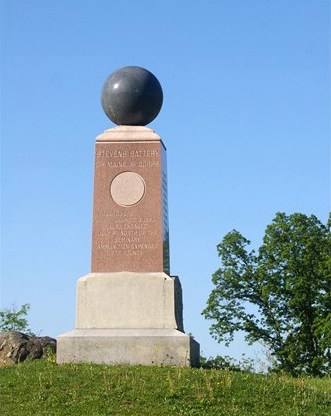Major Greenlief T. Stevens
By Linda Snow McLoon
After four long years of bloody combat on American soil during the Civil War, hostilities finally came to a close in April, 1865. This year, as we commemorate the 150th anniversary of Robert E. Lee’s surrender to General Grant to end the war, the town of Belgrade remembers and honors an unsung Civil War hero of our own, Brevet Major Greenlief T. Stevens.
The youngest of seven children of Daniel and Mahala (Smith) Stevens, Greenlief Stevens was born in Belgrade in 1831 in the house his father built on the Old Winthrop Road, or Rte. 135. During negotiations for the purchase of the farm from Boston parties in 1796, Greenlief’s grandfather, William Stevens, twice rode on horseback from Belgrade to Boston and back.
Greenlief read law with Hon. Samuel Titcomb of Augusta after graduating from Titcomb Belgrade Academy and the Litchfield Liberal Institute. He was subsequently admitted to the Cumberland Bar and accepted into the senior class of the Law Department at Harvard University. The Civil War had broken out at the time of his graduation, and on January 31, 1862, at age 30 he was commissioned first lieutenant in the Fifth Battery, Mounted Artillery, Maine Volunteers, for a three year enlistment. Later that year, Greenlief’s wife, Mary Ann Yeaton Stevens, gave birth to a son, Don Carlos Stevens, in Cambridge, MA.

Civil War cannoneers & gunners at Chancellorsville
Three years and five months later, when Greenlief Stevens and his regiment were mustered out at the war’s conclusion, Stevens had risen to the rank of brevet major, a jump from first lieutenant. Let’s reflect on how Stevens’s service earned him various promotions, praise and respect during his years in the military and beyond.
Following artillery training in early 1862, the 5th Maine Battery was sent into the field in May. During the Second Battle of Bull Run in August, 1862, one of its guns helped cover the army’s retreat. Later that year, the battery was part of the Union’s left flank at the Battle of Fredericksburg.
On May 3, 1863, in the Battle of Chancellorsville, the 5th Maine Battery was supporting the Second Corps near the Chancellor House when it came under heavy fire from Confederate guns. The battery was credited with helping the 1st division of the Second Corps withdraw from a dangerous position. When Capt. Leppien and Lt. Kirby were mortally wounded in the battle, Lt. Stevens took over command of the battery. Later Stevens was knocked over by a shell that tore away the clothing on one side of his body, yet only caused a slight flesh wound. He retained command of the battery, which lost a quarter of its personnel killed or wounded.
Stevens continued to command the battery after Chancellorsville, being promoted to the rank of Captain on June 21. As the battery moved its six brass 12-pounder Napoleons on the long march toward Gettysburg that month, Capt. Stevens now commanded 83 Maine men plus soldiers from a New York regiment for a total of 136 present for duty. The unit was referred to as “Stevens’ Battery.”
Arriving in Gettysburg close to noon on July 1, Stevens had orders to place his battery on Seminary Ridge. When Confederate Major General Pender’s three brigades attacked the ridge, Stevens’ Battery began firing canister charges and then double canister that barely cleared the heads of the 150th Pennsylvania and 7th Wisconsin regiments in front of them. The effect of the canister stopped Pender’s men cold, with only one flag bearer reaching the Union line.
But when charged by fresh North and South Carolina regiments that outnumbered them almost 5 to 1, the Union line collapsed. While in retreat, the 5th Maine Battery experienced some difficulty bringing their guns down the eastern slope of the ridge. A wheel of one of the guns came off, and the axle fell to the ground. The team was halted, the gun raised by cannoneers, and the wheel replaced. At that moment, Capt. Stevens sprang from his horse, and seizing the gunner’s pinchers, inserted the handle for a lynch-pin, so that the gun was saved from capture.
Stevens’ Battery was repositioned on the knoll between Culp’s Hill and East Cemetery Hill, which after the battle was given the name Stevens’ Knoll. During the night, Stevens directed that earthworks be constructed, which on the two days following proved a great service in protecting the men and pieces. He is also given credit for using a French “ordnance glass” as a range finder to improve the performance of the guns.

Horse ambulances brought wounded soldiers to field hospitals not far from the front lines.
Late in the afternoon of the second day, while observing enemy movements, Stevens was wounded by a Confederate sharpshooter, sending a bullet through both of his legs below the knee, and he was carried from the field. Not many months later, in the fall of 1863, Stevens chose to return to his command before his wounds were fully healed, in order to lead his regiment in the Bristoe Campaign and Battle of Mine Run.
Surviving war letters from Greenlief Stevens to his sister and brother-in-law in Belgrade, Rufus and Love Stevens Stuart, shed light on the approaching Battle of the Wilderness:
Headquarters 5th Battery Maine Vol.
Second Brigade Artillery Reserve
April 28, 1864
Dear Brother & Sister,
We have got a great army once more and must fight another battle within a few days. It is safe to say I think that this Army is one hundred thousand strong. It is reported this evening that Burnside left Alexandria yesterday with thirty thousand men, and is marching in the direction of Fredericksburg. He will probably join our left.
Yours most respectfully,
G.T. Stevens
A few days later Stevens continued the letter:
Brother Rufus!
The Army moves tomorrow morning at 3 o’clock. Before this reaches you another great battle will probably be fought. If Lee’s Army is destroyed, the Rebellion will soon close. If it is the misfortune of our Army to fare that fate, then the Confederacy is a fixed fact, and we are fighting in vain.
What we are doing this afternoon and what the conversation is would be interesting no doubt to you, but I cannot find time to write. Burnside’s troops, some of them, are within half a mile of us. They are on the North side of the Rappahannock. What part they are to perform, I am unable to say. Our pontoon bridges on the Rappahannock were taken up last Sunday. Those of Burnside’s Army were placed in the River on Monday. I think Grant is going to strike for the enemy’s front and center. It is reported that we cross the Rapidan at Gemania Ford. It must be a bloody crossing in front of their works. The Heavy Artillery are now striking their tents. They march this evening.
My brave chum and tent mate Lieut. Hunt is now packing his valise. I have just heard him say he wanted someone to take his gold watch and money. I saw him fall on July 1st last year, but hope both of us will be more fortunate in this campaign. Remember me to Mother and all. Please write!
Most respectfully yours,
G.T. Stevens
The Battle of the Wilderness that the 5th Maine Battery played a role in was fought May 5-7, 1864, in Spotsylvania and Orange County, Virginia. Grant’s Army of the Potomac’s IX Corps, 101,895 men strong, met Robert E. Lee’s Army of Northern Virginia’s 61,025 men. Casualties & losses: North – 17,666: South – 11,033. Despite these heavy losses, the results of the battle were inconclusive.
In June, the 5th Maine Battery was plunged into the thick of the battle at Cold Harbor, VA. The artist, Alfred R. Waud, from Harper’s Weekly, caught up with the Stevens Battery on the battlefield and sketched this battle scene:
The accompanying June 15, 1864 Harper’s Weekly article described the scene at Cold Harbor:
“In the battle at Cold Harbor on June 1, Stevens’ Battery, belonging to the Sixth Corps, was so near the rebel lines that the soldiers nicknamed it “Battery Insult.” It stirred up the rebels in a most aggravating manner, and was an excessively dangerous spot to be seen in. After a discharge of the pieces, hundreds of bullets would zip through the embrasures and around the earth works; occasionally round shot would batter down portions of the work, but the artillerists stuck to it and did good execution. It will be noticed that the limber chests have been taken off the carriages and placed in trenches dug for their security.”
The following year the 5th Maine Battery participated in the Battle of Spotsylvania Court House and the Battle of North Anna. Later the 5th Maine Battery became part of the Army of the Shenandoah under Sheridan. Stevens was engaged in the three great battles which resulted in the complete destruction of the rebel army under Confederate General Early – Cold Harbor, Winchester, and Cedar Creek. A field correspondent of the New York World described the great crisis in the Battle of Winchester as follows:
“The moment was a fearful one; such a sight rarely occurs more than once in any battle as was presented on the open space between two pieces of woodland into which the cheering enemy poured. The whole line, reckless of bullets, even of the shells of our battery, constantly advanced. Captain Stevens’ battery, the Fifth Maine, located immediately in their front, poured its fire unflinchingly into their columns to the last. A staff officer riding up warned the regiment to the rear, to save it from capture. But the battery did not move – the men loading and firing with the regularity and precision of a field day. The foe advanced to a point within two hundred yards of the muzzles of Captain Stevens’ guns.”
Colonel C.H. Tompkins, Chief of Artillery, Sixth Corps, said, “However trying the circumstances, Captain Stevens has always been found equal to the occasion.”
On a request for Stevens’s promotion, written without his knowledge, General Wright, Commander of the Sixth Corps, indorsed:
“The gallant and important services rendered by Captain Stevens, of which I was personally cognizant, make it my duty to bring his merits before the authorities of his state, and ask for him at their hands such acknowledgment in the way of promotion as it is in their power to bestow.”
On February 14, 1865, Greenlief T. Stevens was promoted to Brevet Major for gallant and meritorious conduct at the battles of Cold Harbor, Winchester, and Cedar Creek. His correspondence to family at home reflects his customary modesty:
Frederick, Maryland – March 13, 1865
The Belgrade Boys are all well. My nomination
by the President as Brevet Major was confirmed in the Maine State Senate on February 14. I have no particular news to write.
In another letter home, Greenlief Stevens commented on the loss of Flora, a young daughter of Rufus and Love Stevens Stuart, who was a victim of diphtheria:
Dear Brother & Sister!
A word from George this evening brought the sad news that Flora was dead. It seems as though this cannot be true. I cannot have it that so good, intelligent, and so clever a girl as Flora is dead, one that everybody loved and always spoke so highly of. It seems as though this is more than you can bare. I know that you must feel as though you have but little to live for. I have thought many times that you lived and toiled for her, which was a pleasure for you to do more than for all the World besides. On April 17th George wrote that she was very sick. Indeed, but the doctor thought she was doing well. On the 23rd he wrote again that she was worse and that her case looked very dark to him.
At the close of the war, Major Stevens was mustered out of service with his battery on July 6, 1865, having served three years and five months. The 5th Maine Mounted Battery lost more men in killed and wounded in the three great battles of Chancellorsville, Gettysburg, and Cedar Creek than any other battery in a like number of battles in the War of the Rebellion, either volunteer or regular.
Back in civilian life in Maine, Greenlief Stevens returned to his law profession and opened a law office in West Waterville, now Oakland, where he, his wife Mary Ann, and their only surviving child, Don Carlos Stevens, resided. Three other children – Ala Ray, Rupert, and Jessie – all died young. Later the Stevens family lived at 44 Green Street in Augusta.
Major Greenlief T. Stevens was elected to the Maine House of Representatives in 1875, and two years later to the State Senate, serving on the legal affairs, railroads, and military affairs committees. In 1882, he was commissioned colonel and assigned by Maj. Gen. Joshua L. Chamberlain to duty as chief-of-staff of the First Division Maine Militia. He was a member of the Maine Gettysburg Commission and widely known in Grand Army of the Republic circles. He was also twice elected to the office of Sheriff of Kennebec County before becoming a probate judge in 1892.
Mary Ann Stevens passed away on July 7, 1904 at age 71 due to heart disease, leaving her husband a widower for fourteen years until his death on December 21, 1918. Both are buried, along with three of their four children, in the Woodside Cemetery in Belgrade. Their only surviving child, Don Carlos Stevens, became a Unitarian minister and librarian in Fairhaven, Massachusetts. Eventually he returned to Maine and followed in his father’s footsteps as a member of the State Legislature.
Many years have passed since our nation was embroiled in the Civil War, but the people of Belgrade and the State of Maine should proudly remember Greenlief T. Stevens, a son of Belgrade who displayed remarkable courage and leadership for his country.
Belgrade residents who served in the 5th Maine Mounted Artillery Battery:
1. * Asa J. Cummings – Belgrade – Private – Age 19 – Died March, 1862
2. * Thomas W. Damon – Belgrade – Private – Age 27 – Died 1864
3. Henry Frost – Belgrade Mills – Private – Age 18
4. Charles A. Hinkley – Belgrade – Private – Age 19
5. * Charles H. Littlefield – Belgrade – Private – Age 18 – Died at Fredrick, MD April 25, 1865
6. James A. Lombard – Belgrade – Private – Age 20 – Wounded
7. John Partridge – North Belgrade – Private – Age 43
8. George R. Stevens – Belgrade – Corporal – Age 36
9. Greenlief T. Stevens – Belgrade/Augusta – Captain /Brevet Major – Age 30 – Wounded
10. Hiram G. Wellman – Belgrade – Private – Age 18
Many thanks to John Stuart and Bob Lewis, who were generous with their materials and researching expertise, making this web-exhibit possible.
References consulted:
- Greenlief T. Stevens – Wikipedia
- Harper’s Weekly, June 25, 1864
- Illustrated History of Kennebec County – 1892
- Letters of Greenlief T. Stevens – courtesy of John M. Stuart
- Maine at Gettysburg – Maine Gettysburg Commission – 1898
- Officers of the Volunteer Army and Navy who Served in the Civil War – 1893
- Representative Men of Maine – Henry Chase – 1893
- The Civil War Day by Day – John S. Bowman – 1989
- Town of Belgrade, Past and Present – 1796-1996
- Turning the Tide at Gettysburg – Jerry R. Desmond – 2014
















